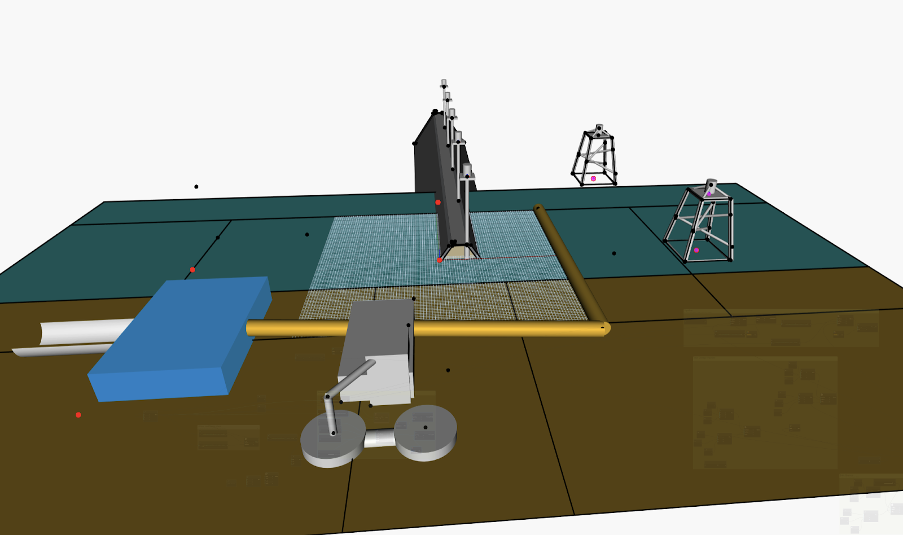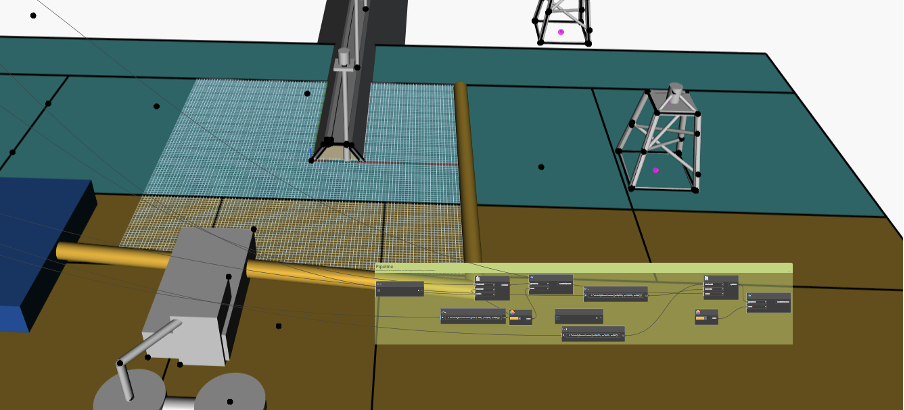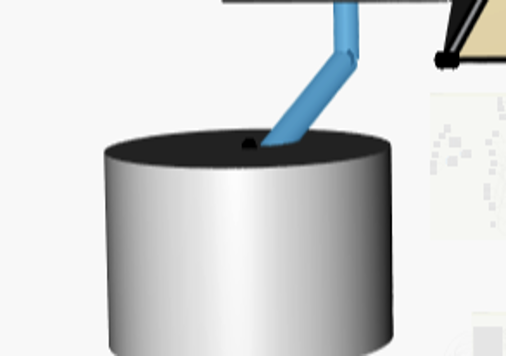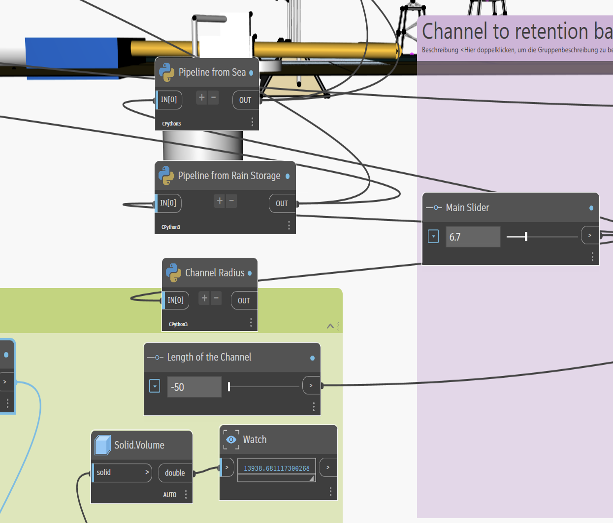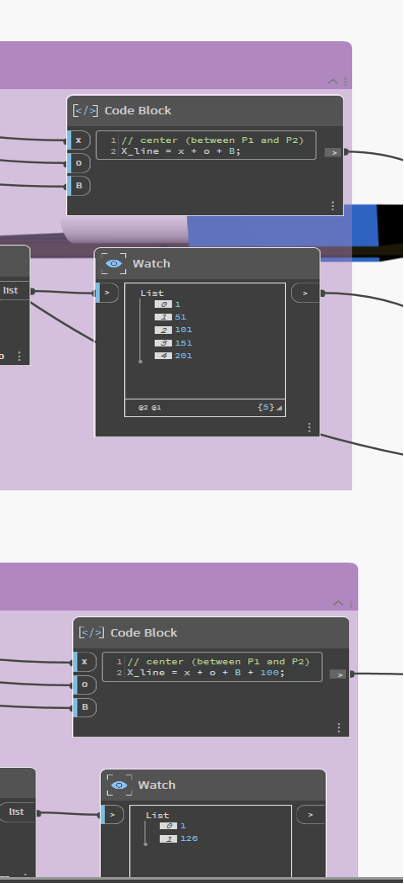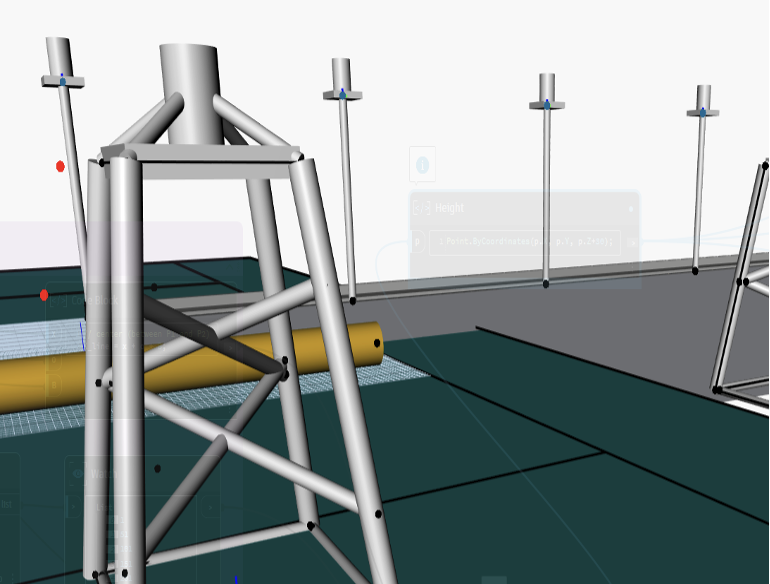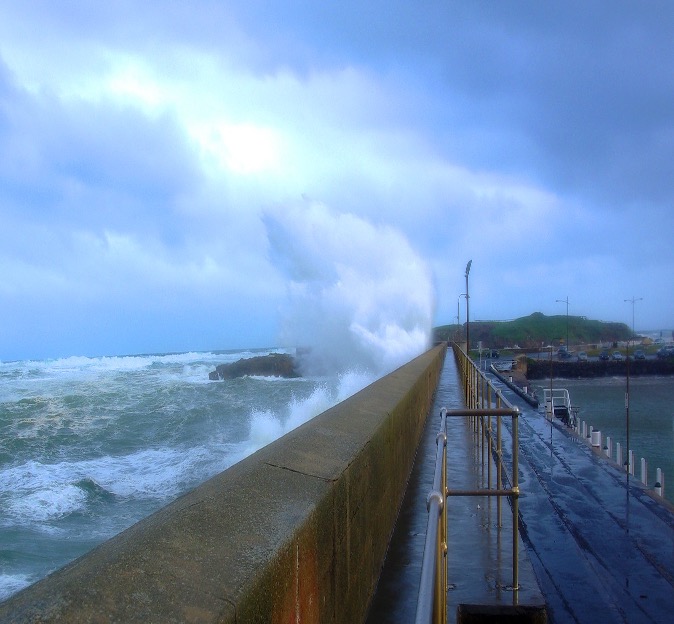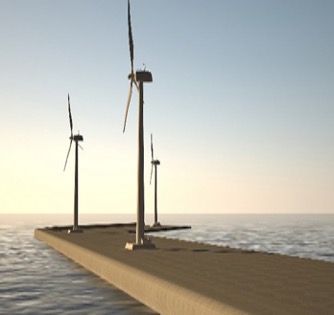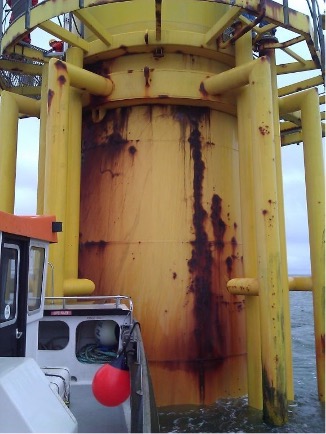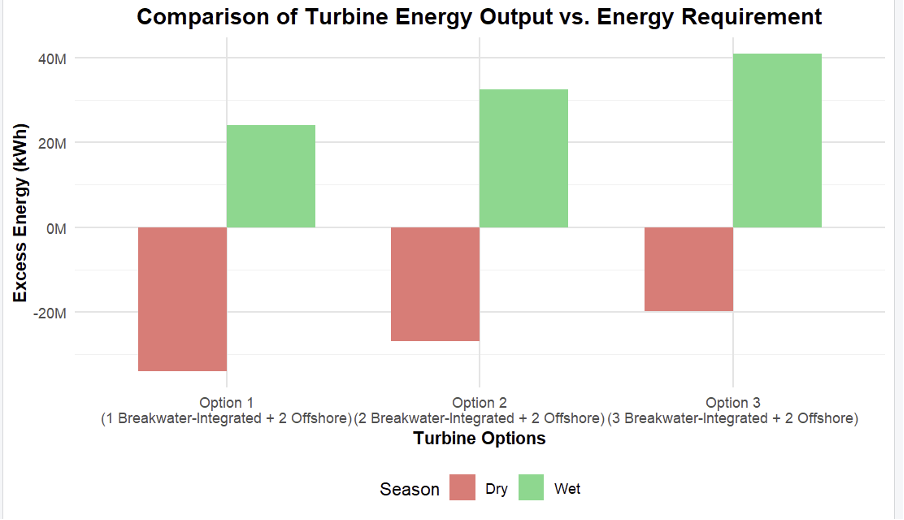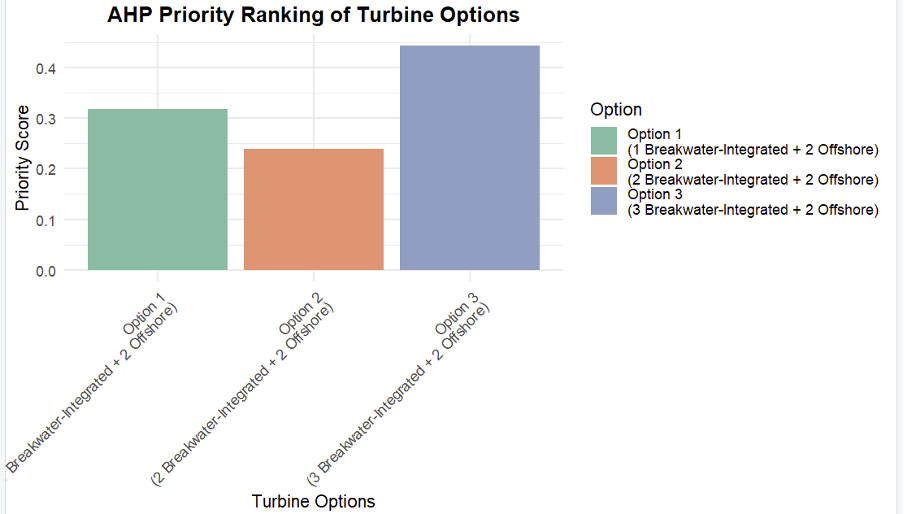Design Challenge: Sustainable Water Treatment and Renewable Energy Integration
This project focuses on an innovative, integrated system designed to address the challenges of sustainable water treatment and renewable energy generation while meeting urban agricultural water demands. At its core, the system combines multiple interconnected components, each playing a crucial role in ensuring efficiency, sustainability, and resource optimization.
The Retention Basin stores rainwater in the wet season, adapting its size based on rainfall patterns and land availability. It manages overflow to prevent flooding, ensuring reliable water storage.
The Sustainable Treatment Plant handles both rainwater and seawater, adjusting its capacity based on seasonal water availability. It ensures a consistent water supply for agriculture, reducing energy use during the wet season.
The Wind Turbine Farm generates renewable energy to power the treatment processes. Its placement is optimized for maximum energy efficiency, minimizing reliance on external sources.
The breakwater protects the infrastructure from erosion and waves, including the pipeline for collecting seawater for treatment and the wind turbine farm. Its design is optimized to use the minimum amount of material and ensure protection.
To assess the performance of the design of the integrated system, two High-Priority Criteria (HPC) were selected:
Minimizing Energy Consumption: By prioritizing rainwater treatment whenever possible, the system reduces dependence on seawater treatment, which is more energy-intensive.
Minimizing Material Usage: The breakwater’s design is optimized to use the least amount of concrete necessary while maintaining its protective and supportive functions.
Together, these elements form a cohesive and efficient system where each component complements the others, creating a robust solution for urban agricultural water management. By integrating sustainable water treatment with renewable energy generation, the system not only meets agricultural needs but also exemplifies a forward-thinking approach to environmental stewardship and resource management.
The parametric model allows urban planners to adjust the design based on local conditions. It enables flexible modifications to the retention basin, turbines, and breakwater to maximize efficiency and sustainability of the water treatment plant. This adaptability ensures that the system meets agricultural water demands while minimizing environmental impact and energy use.
Logic of the Parametric Model
Our integrated system consists of three primary subsystems: the breakwater, wind turbines (both integrated with the breakwater and offshore), and the flood retention basin. Together, these components support urban water treatment and rainwater storage for agriculture.
- Breakwater Functionality: The breakwater protects the pipeline infrastructure and offshore wind turbine foundations while also supporting monopile wind turbines integrated with its structure.
- Wind Turbine Adaptability: The number of wind turbines is fully adjustable, scaling based on energy demand and water treatment needs. Offshore turbines maximize energy yield, while breakwater-integrated turbines provide localized power for water treatment.
- Flood Retention Basin Capacity: Designed with a flexible storage capacity, the basin manages both flood control and agricultural water supply, adapting to seasonal rainfall variations.
- Adaptive Resource Management: The system dynamically adjusts to operational and seasonal demands. Key parameters such as breakwater length, number of wind turbines, and pipeline diameter are adaptable, ensuring an optimized balance between energy generation, water treatment, and resource distribution.
In Dynamo, we integrated an adaptive pipeline system that adjusts diameters based on seasonal flow variations. The seawater intake pipeline operates within a 0.6m–1.0m range, ensuring efficient water supply during the dry season (Q_dry ≈ 1.60 m³/s). The rainwater pipeline from the flood retention basin to the treatment plant varies between 1.0m–1.5m, accommodating the wet season’s higher inflow (Q_wet ≈ 6.76 m³/s). This dynamic adjustment, controlled in Dynamo, optimizes water treatment efficiency, breakwater integration, and renewable energy production, ensuring a seamless response to seasonal demands.
The main slider serves as the central control for dynamically adjusting the pipeline diameters and water conductivity based on demand. This ensures seamless coordination between the seawater intake, rainwater pipeline, and overall water treatment capacity. Additionally, one of our key design challenges was the need for a larger rainwater storage system, requiring careful definition of the storage volume to accommodate seasonal variations. By integrating these factors, the system effectively balances water availability, pipeline capacity, and treatment efficiency, ensuring optimal performance throughout the wet and dry seasons.
After defining the water demand, we determined the required energy input. To meet this, we incorporated two fixed offshore structures and set adjustable ranges for integrated monopile turbines, ensuring energy distribution is based on demand. This approach allows for dynamic model adjustments, optimizing both water treatment and renewable energy generation.
The flood retention basin capacity is dynamically linked to the water demand defined in Dynamo. By adjusting storage volume based on seasonal inflows, the system ensures efficient water retention, treatment, and distribution, maintaining balance between flood control and agricultural supply.
he environmental impact of concrete, particularly in marine environments, is a significant consideration due to its high carbon footprint from cement production. The extraction and transportation of raw materials, such as limestone and sand, contribute to environmental degradation and energy consumption. In offshore applications, concrete structures like breakwaters and foundations can also pose challenges due to potential leaching of chemicals into surrounding waters, which may affect local marine life. However, the use of alternative materials such as low-carbon cement or recycled aggregates, along with optimization of concrete mixes for durability and reduced environmental footprint, can help mitigate these negative effects. Furthermore, careful management of concrete waste during construction and decommissioning processes can reduce pollution and support sustainable practices.
The quantity of concrete is also quantified with the breakwater integrated, which will enhance the structural performance of the monopile foundation, including the piles and their associated weight distribution. This integration contributes to the overall stability and functionality of the breakwater system.
As mentioned above, some variables were fixed, while others were user-controlled adjustable parameters that varied within defined ranges. All parameters and their sources are summarized in Table 1
| Parameter | Description | Value | Comments/Calculations |
| D | Demand of water | 38.130.000 m3 per year | Water used per hectare:623.000.000 m3 / 506.500 hectares = 1.230 m3/hectare [1] [2]Assumption: 50.000 people city Land area = 50.000 people * 0,62 hectare/person [3] = 31.000 hectaresWater needed = 31.000 hectares * 1.230 m3/hectare = 38.130.000 m3 per year |
| Qr | Rainwater (runoff) volume | 106.500.000 m3 – 2.298.000.000 m3 | Rainwater (runoff) volume = rainfall (mm) x catchment area (m2) x runoff coefficientRainfall: 7,1 mm (1 year event and 5 minutes duration) or 153,2 mm (100 year event and 168 hours duration) [4]Minimum rainwater = 7,1 mm (= l/m2) x 25.000.000 m2 x 0,6 = 106.500.000 m3 [5] [6] [7]Maximum rainwater = 153,2 mm (= l/m2) x 25.000.000 m2 x 0,6 = 2.298.000.000 m3 [5] [6] [7] |
| W_rb | Width of Retention basin dimension | 150 m | constant value [8] |
| L_rb | Length of Retention basin dimension | 80 m or 335 m | According to small and large basins. [8] |
| D_rb | Depth of Retention basin dimension | 4 m or 20 m | According to small and large basins. [8] |
| Water collected in basin (= volume of basin) | 50.000 m3- 1.000.000 m3 | Small basin for minimum rainwater:Volume = 50.000 m3Large basin for maximum rainwater: Volume = 1.000.000 m3 Values: Wdidth, Length, Depth, previously defined. Amount on rainwater percentage into the basin: % of minimum rainwater in the small basin = 50.000 m3 / 106.500.000 m3 = 0,047 % % of maximum rainwater in the large basin = 1.000.000 m3 / 2.298.000.000 m3 = 0,044 % | |
| Er | Energy intensity for rain water | 1.88 kWh/m3 | Energy intensity for rainwater harvesting systems typically ranges from 1,40 kWh/m3 with UV disinfection adding up to 0,48 kWh/m3 in some cases. [9] |
| Es | Energy intensity for seawater | 3.29 kWh/m³ | Energy intensity for seawater desalination is from 2,98 kWh/m3 to 3,60 kWh/m3 for reverse osmosis. [9] [10] |
| L_breakwater | Length breakwater | 100 m – 400 m | The minimum value was defined to protect the pipeline for collecting seawater for treatment and the maximum to protect the wind turbines. |
Amount of energy required for different seasons with the parameter D
The following table shows the calculations for the total amount on energy for the treatment processes for wet and dry seasons:
| Season | Percentage of rainwater (%) | Amount of rainwater (m3) | Percentage of seawater (%) | Amount of seawater (m3) | Energy for rainwater treatment (kWh/m3) | Energy for seawater treatment (kWh/m3) | Total amount on energy (kWh) |
| Wet | 90 | 34.317.000 | 10 | 3.813.000 | 1,88 | 3,29 | 77.060.730,00 |
| dry | 10 | 3.813.000 | 90 | 34.317.000 | 1,88 | 3,29 | 120.071.370,00 |
Experiments and results
The following table shows the different options for the amount on wind turbines based on the total amount on energy needed:
For this project, we have selected two offshore turbine models and two breakwater-integrated turbine models based on their suitability for the design requirements. The Siemens Gamesa SG 14-222 DD (14 MW, CF ~50%) [11] and Vestas V236-15.0 MW (15 MW, CF ~50%) are chosen for their high capacity and efficient performance in offshore conditions. For the breakwater-integrated turbines, we are opting for the GE Cypress 6.1 MW (CF ~35%) [12] and Enercon E-160 EP5 (5.5 MW, CF ~35%), which are well-suited to the unique demands of breakwater integration, offering reliable energy production in more constrained environments.
The amount of water flowing through the parabolic wall of the breakwater significantly affects the performance of the breakwater-integrated turbines. As water flow increases, it can enhance the hydrodynamic forces acting on the turbine rotors, potentially improving their efficiency by providing more consistent water-driven motion [13]. However, excessive water flow can also lead to turbulent conditions, which may negatively impact the stability of the rotors and their energy production [14]. Therefore, the design of the breakwater wall must ensure that the water flow is optimized to balance maximum energy capture with rotor protection, maintaining steady and predictable energy output [15].
Additionally, breakwater integration plays a crucial role in reducing fatigue for offshore wind turbines by offering natural protection from harsh marine environments. The breakwater structure helps to attenuate wave forces, reducing the impact of extreme weather conditions on the turbine foundations and structural components [16]. This protection can extend the lifespan of the turbines by minimizing wear and tear, ultimately reducing maintenance needs and improving operational efficiency [17]. The design of the breakwater system thus provides both a physical shield and a more stable operating environment, leading to lower fatigue-related failure rates for offshore wind turbines [18].
The chart compares three turbine configuration options, assessing their energy output against required energy levels during wet and dry seasons.
- Option 1 (1 Breakwater-Integrated + 2 Offshore) generates a surplus of approximately 25 million kWh in the wet season but experiences a deficit of around 25 million kWh in the dry season.
- Option 2 (2 Breakwater-Integrated + 2 Offshore) improves performance, achieving a wet season surplus of about 32 million kWh while reducing the dry season deficit to approximately 17 million kWh.
- Option 3 (3 Breakwater-Integrated + 2 Offshore) demonstrates the best performance, with the highest wet season surplus of around 40 million kWh and the smallest dry season deficit of about 10 million kWh.
All options generate excess energy during the wet season but experience shortfalls in the dry season to varying degrees. The analysis highlights that Option 3 provides the most balanced energy production across seasons while minimizing shortfalls.
The AHP analysis evaluated three turbine configuration options based on key criteria, including wet season production, dry season production, cost, and installation complexity. The results revealed:
- Option 3 (3 Breakwater-Integrated + 2 Offshore turbines) ranked highest, achieving the best overall score. It demonstrated superior energy production across both seasons while maintaining a balanced cost and installation complexity.
- Option 1 (1 Breakwater-Integrated + 2 Offshore turbines) ranked second, offering moderate performance with a balance between energy production and practical considerations.
- Option 2 (2 Breakwater-Integrated + 2 Offshore turbines) ranked lowest, primarily due to its lower priority score, indicating less favorable performance in energy production and feasibility.
Consistency Ratios (CR) for all matrices remained within acceptable limits (<0.1), ensuring a reliable decision-making process. Based on this analysis, Option 3 emerges as the optimal configuration, effectively balancing energy production with practical implementation factors.
SketchFab View
References
[1] Irrigation total water use in Germany 2019: 623 million m3 https://www.destatis.de/EN/Themes/Society-Environment/Environment/Environmental-Economic-Accounting/raw-material-flows-water/Tables/use-of-water.html
[2] Total irrigated outdoor area in Germany 2019: 506.500 hectares https://www.destatis.de/EN/Press/2021/10/PE21_494_412.html
[3] The agricultural land footprint of German consumption was 0.62 hectares per person in 2015 https://www.monitoring-biooekonomie.de/en/topics/origins/agriculture-crops-and-livestock
[4] KOSTRA TABELLEN https://www.openko.de/maps/kostra_dwd_2020.html#9/53.5583/8.1601; https://www.openko.de/kostra-dwd-2020-rasterfeld-nr-81118/
[5] KOSTRA-DWD-2020; Hinweise und Hilfestellungen zur Verwendung des KOSTRA-DWD-Datensatzes Version 2020;Thomas Junghänel, Dr. Jennifer Ostermöller und Dr. Thomas Deutschländer; Deutscher Wetterdienst Abteilung Hydrometeorologie; Offenbach am Main, Juni 2023, page 7
[6] Uni.-Professor R. Hinkelmann, Lecture Engineering Hydrology – Hydrological Modeling Techniques; Chair of Water Resources Management and Modeling of Hydrosystems, Department of Civil Engineering, Technische Universität Berlin (Dezember 2021)
[7] Li, Zhifeng & Wu, L. & Zhu, Wei & Hou, Miaole & Yang, Yizhou & Zheng, Jianchun. (2014). A New Method for Urban Storm Flood Inundation Simulation with Fine CD-TIN Surface. Water. 6. 1151-1171. 10.3390/w6051151.
[8] DIN 19700-12:2004-07
[9] Vieira, A.S. Beal, C.D. Ghisi, E. Stewart, R.A. (2014) Energy intensity of rainwater harvesting systems: A review. Renewable and Sustainable Energy Reviews, Volume 34, June 2014
[10] Juan Miguel Pinto, Energy Recovery Inc. Energy Consumption and Desalination May 07, 2020, University of Houston
[11] Siemens Gamesa SG 14-222 DD Offshore Turbine: https://www.siemensgamesa.com/
[12] GE Cypress 6.1 MW Onshore Turbine: https://www.ge.com/renewableenergy
[13] Smith, C., & Liu, H. (2021). Structural basis for continued antibody evasion by the SARS-CoV-2 receptor binding domain. Science, 373(6556), 1519-1526. https://www.science.org/doi/10.1126/science.abl6251
[14] (Miller, 2020)
[15] (Jones et al., 2022)
[16] (Taylor & Green, 2021)
[17] (Davis, 2020)
[18] Nguyen, T. H. O., et al. (2022). Robust SARS-CoV-2 T cell responses with common TCRαβ motifs toward COVID-19 vaccines in patients with hematological malignancy impacting B cells. Cell Reports Medicine, 4(1), 101017. https://www.pnas.org/doi/abs/10.1073/pnas.2411428121
